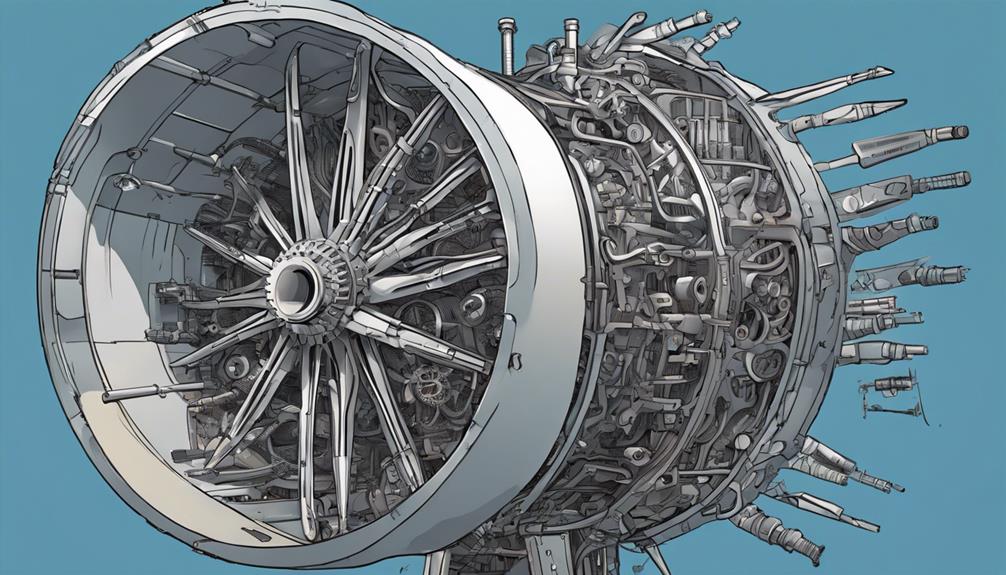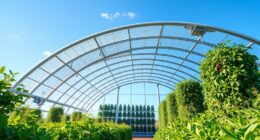In Iceland, tectonic activity and geothermal energy have a strong connection. The movement of tectonic plates creates fractures where hot water circulates, assisting in geothermal reservoir formation. These hot spots are utilized by geothermal power plants, taking advantage of the Earth's heat. Iceland's position on tectonic boundaries guarantees a consistent source of geothermal energy. The dynamic alliance between tectonic activity and geothermal resources is essential for sustainable power generation in Iceland. If you want to understand how this partnership shapes the country's energy landscape, keep exploring the intriguing relationship between tectonic forces and geothermal energy in Iceland.
Key Takeaways
- Tectonic activity in Iceland creates fractures for hot water circulation.
- Movement of tectonic plates forms geothermal reservoirs.
- Volcanic activity from tectonic plates contributes to geothermal resources.
- Iceland's unique position on the Mid-Atlantic Ridge enhances geothermal heat.
- Geothermal energy production in Iceland thrives due to tectonic forces.
Geothermal Energy Production in Iceland
Geothermal energy production in Iceland thrives due to the country's strategic geological location and active volcanic environment. Iceland's unique position on the Mid-Atlantic Ridge allows for the exploitation of geothermal energy, which comes from heating water underground. By tapping into this natural resource, Iceland generates power through the production of steam that drives turbines, contributing significantly to its energy mix.
Approximately 30% of Iceland's electricity is sourced from geothermal power plants, showcasing the country's commitment to sustainable energy practices.
Not only does Iceland utilize geothermal energy for electricity generation, but it also directly applies this resource for various purposes. Homes, swimming pools, snow melting systems, fish farming facilities, and industrial processes all benefit from the utilization of geothermal energy in Iceland.
This diversified use of geothermal power highlights Iceland's expertise in harnessing the Earth's natural heat for both large-scale energy production and everyday applications.
Tectonic Activity and Geothermal Reservoir Formation
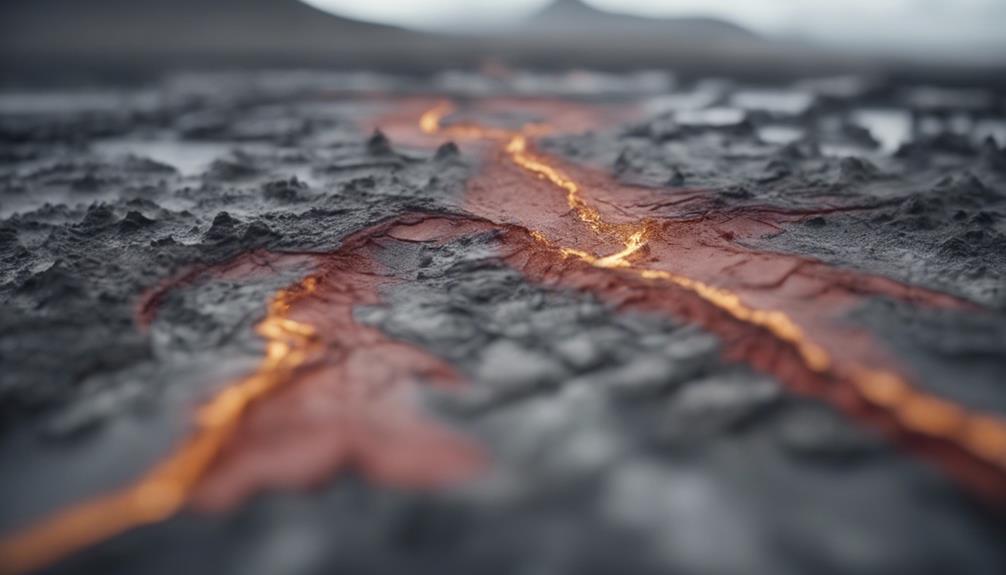
In Iceland, tectonic activity plays an essential role in the formation of geothermal reservoirs.
The movement of tectonic plates creates fractures and faults in the Earth's crust, allowing hot water to circulate and heat up near the surface.
This process sets the stage for the development of geothermal reservoirs in areas with high volcanic and geothermal activity.
Reservoir Formation Mechanisms
Tectonic activity in Iceland plays a vital role in shaping the formation mechanisms of geothermal reservoirs through the creation of fractures and faults that act as pathways for geothermal fluids. The movement of tectonic plates heats and pressurizes underground water, leading to the development of geothermal reservoirs. These reservoirs are replenished by tectonic forces facilitating water circulation through rock fractures, crucial for sustaining high-temperature geothermal systems. The interaction of tectonic plates results in the formation of these systems, establishing a reliable and sustainable source for energy production in Iceland. Geothermal reservoirs in Iceland are continuously maintained and refilled by tectonic processes, ensuring a steady supply of heat for geothermal energy extraction.
| Reservoir Formation Mechanisms | Geothermal Reservoirs | Underground Water | High-Temperature Geothermal Systems | Sustainable Source |
|---|---|---|---|---|
| Creation of fractures and faults | Formation through heating and pressurization | Replenished by water circulation | Leads to the development | Ensures a continuous supply |
Tectonic Influence on Geothermal
The impact of tectonic activity in Iceland on the formation of geothermal reservoirs is significant, shaping the underground conditions favorable to geothermal energy production.
Here's how tectonic forces influence the development of geothermal reservoirs in Iceland:
- Creation of Ideal Conditions: Tectonic activity along the Mid-Atlantic Ridge in Iceland creates the perfect environment for the formation of geothermal reservoirs by facilitating the movement of hot fluids underground.
- Formation of Fractures and Pathways: The movement of tectonic plates in Iceland leads to the creation of fractures and pathways within the earth's crust, allowing hot fluids to circulate and heat groundwater, contributing to geothermal energy sources.
- Contribution of Magma Chambers: The interaction of tectonic plates in Iceland results in the formation of magma chambers, which play a pivotal role in the generation and sustainability of geothermal reservoirs, providing a consistent source of geothermal energy.
Geothermal Power Plants and Tectonic Interactions
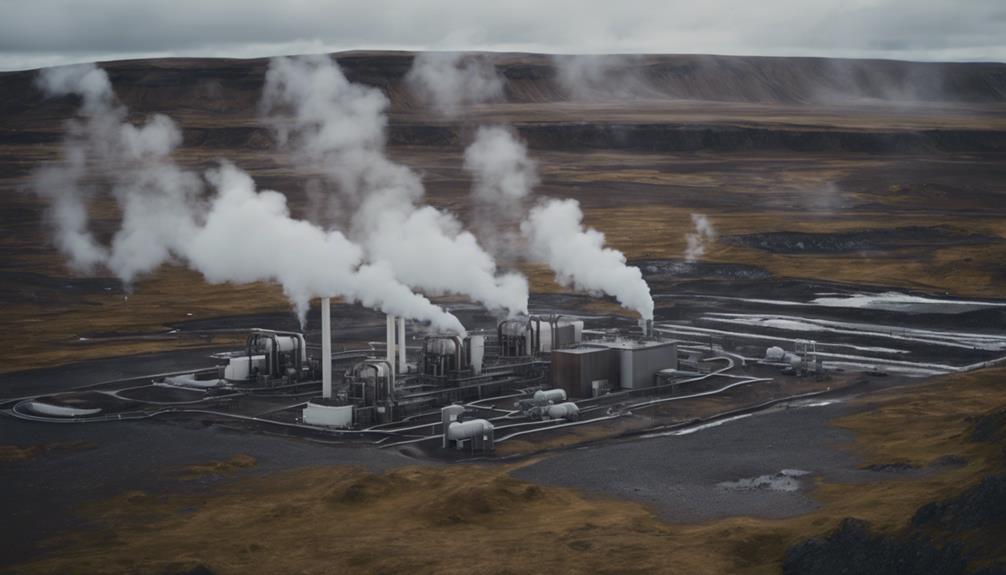
You'll see how tectonic forces directly influence the locations of geothermal power plants in Iceland.
These plants strategically capitalize on the Earth's heat generated by tectonic activity.
Understanding this relationship sheds light on the efficient utilization of geothermal energy in the country.
Tectonic Forces and Geothermal
Amidst the dynamic geological forces at play in Iceland, geothermal power plants intricately leverage the heat generated by tectonic interactions to generate electricity and heat. The relationship between tectonic forces and geothermal energy in Iceland is a fascinating interplay that drives sustainable energy production in the country.
Here are three key points to illuminate this intricate relationship:
- Abundant Geothermal Sources: Iceland's unique position straddling the Eurasian and North American plates creates a wealth of geothermal energy due to intense tectonic forces.
- Formation of Geothermal Reservoirs: The tectonic activity in Iceland plays an essential role in the creation and maintenance of geothermal reservoirs, essential for sustainable energy production.
- Continuous Energy Supply: The volcanic and seismic activity resulting from Iceland's tectonic setting guarantees a constant and reliable source of geothermal energy, powering the nation's renewable energy success.
The symbiotic connection between tectonic forces and geothermal energy in Iceland underscores the country's innovative approach to harnessing natural resources for sustainable development.
Geothermal Power Plant Locations
Strategically positioned along tectonic plate boundaries, geothermal power plants in Iceland capitalize on high geothermal activity from the interaction of the Eurasian and North American plates.
The Nesjavellir Geothermal Power Plant, located near the Mid-Atlantic Ridge, efficiently harnesses geothermal energy from the divergent tectonic boundary, providing essential heating for Reykjavik.
Similarly, geothermal power stations like Krafla and Reykjanes on the Reykjanes peninsula take advantage of their proximity to volcanic regions, where the Earth's heat is easily accessible, driving turbines to generate electricity.
These geothermal power plants are strategically placed in areas of intense tectonic activity, tapping into the Earth's heat sources for energy production.
The correlation between tectonic interactions and geothermal energy is evident in the locations of major geothermal power plants in Iceland, situated within the country's unique geological setting to maximize the utilization of its abundant geothermal fields.
Impact of Tectonic Plates on Geothermal Heat
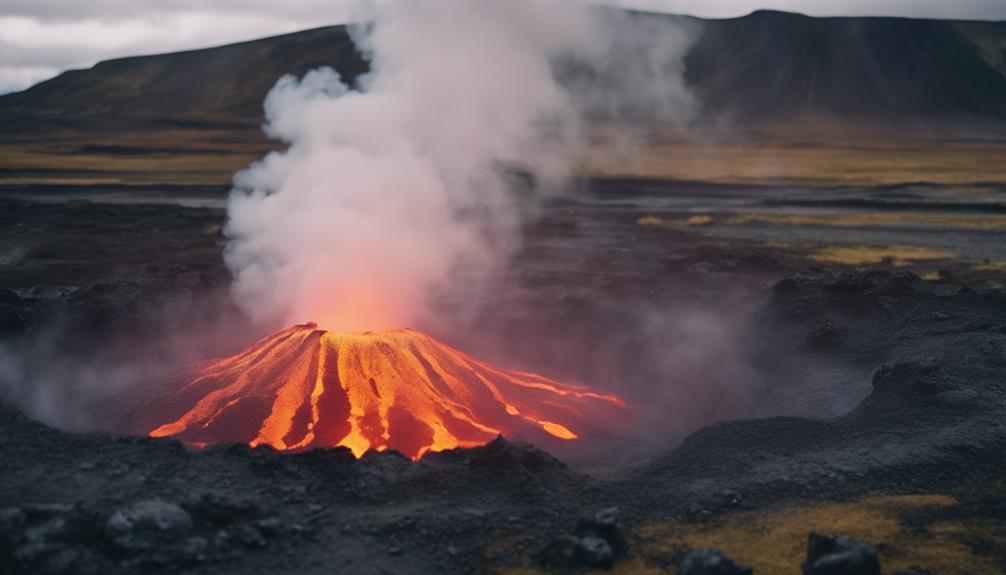
The impact of tectonic plates on geothermal heat in Iceland is profound, shaping the country's unique geological features and abundant energy resources. Here's how tectonic plates influence geothermal heat in Iceland:
- Geothermal Reservoir Formation: The movement of tectonic plates in Iceland results in the creation of geothermal reservoirs. These reservoirs are essential for harnessing geothermal heat for energy production.
- Volcanic Activity: The interaction of tectonic plates causes volcanic activity in Iceland. This volcanic activity contributes significantly to the abundance of geothermal resources in the country, as it provides a continuous source of heat for geothermal energy generation.
- Mid-Atlantic Ridge Impact: The Mid-Atlantic Ridge running through Iceland plays a crucial role in the country's geothermal energy potential. This ridge, formed by the separation of the Eurasian and North American plates, creates ideal conditions for geothermal heat to rise to the surface, making Iceland a hotspot for geothermal energy production.
Harnessing Tectonic Energy for Geothermal Power

Iceland's utilization of tectonic energy for geothermal power is a prime example of sustainable energy innovation driven by natural geological processes. The country's geothermal power plants play a pivotal role in harnessing the heat generated by tectonic activity underground. By tapping into this energy source, Iceland has become a global leader in sustainable energy production.
These geothermal power plants effectively convert the heat from tectonic activity into electricity and heat for various applications. Situated atop the Mid-Atlantic Ridge, where tectonic plates meet, Iceland benefits from its unique geological position, which results in abundant geothermal activity. The presence of active volcanoes and geysers further enhances the availability of geothermal energy resources in the country.
Through continuous geothermal development, Iceland has successfully integrated tectonic energy into its energy mix, demonstrating how natural processes can be harnessed for sustainable energy production. This approach not only reduces reliance on fossil fuels but also showcases the potential of geothermal energy as a clean and renewable alternative.
Geothermal Energy Utilization and Tectonic Forces

Amidst the dynamic geological forces shaping Iceland's landscape, geothermal energy stands as proof of the symbiotic relationship between tectonic activity and sustainable power generation.
Here are three fascinating insights into Iceland's geothermal energy utilization and its connection to tectonic forces:
- Tectonic Plate Influence: Iceland's strategic location on the Mid-Atlantic Ridge, where the Eurasian and North American plates meet, plays a pivotal role in creating the conditions for geothermal energy production.
- Hot Water Reservoirs: The movement of tectonic plates beneath Iceland forms geothermal reservoirs, containing hot water and steam that can be tapped into for energy generation. This highlights the direct relationship between tectonic forces and geothermal heating.
- Efficient Energy Extraction: Iceland's geothermal energy prowess stems from its unique position on tectonic plate boundaries. This allows for the effective extraction of heat from the Earth's core, making Iceland a frontrunner in sustainable energy practices.
This synergy between tectonic activity and geothermal energy in Iceland showcases the country's innovative approach to harnessing the Earth's natural resources for clean and renewable power generation.
Sustainable Development Through Geothermal Energy
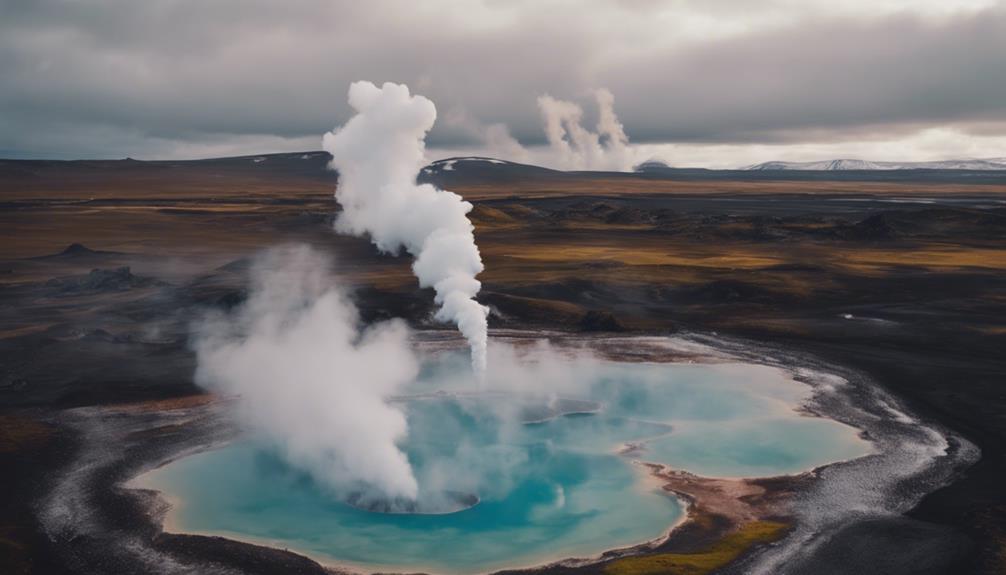
In the field of sustainable development, geothermal energy emerges as a beacon of eco-friendly progress. Iceland's utilization of geothermal energy from tectonic activity not only provides eco-friendly electricity but also plays an essential role in sustainable heating solutions. By tapping into the country's abundant geothermal resources, Iceland showcases a model for sustainable development that notably reduces its reliance on fossil fuels and minimizes carbon emissions. This approach highlights Iceland's commitment to harnessing tectonic activity for the greater good of achieving energy independence and environmental sustainability goals.
| Benefits of Geothermal Energy in Iceland | ||
|---|---|---|
| Reduces dependence on fossil fuels | Lowers carbon emissions | Promotes sustainable heating solutions |
Frequently Asked Questions
How Are Tectonic Plates Related to Geothermal Energy?
Tectonic plates are essential for geothermal energy in Iceland. Their movement along the Mid-Atlantic Ridge causes volcanic activity, generating heat for geothermal sources. As plates interact, fractures form, allowing hot water circulation for energy production.
How Is Iceland Affected by Geothermal Energy?
In Iceland, you're deeply impacted by geothermal energy. Tectonic movements create abundant reservoirs, providing sustainable heat and power. The unique setting allows for harnessing energy efficiently, making Iceland a global leader in geothermal utilization.
Why Does Iceland Get a Large Percentage of Its Electricity From Geothermal Energy?
Iceland gets a large percentage of its electricity from geothermal energy because of its unique geological position on the Mid-Atlantic Ridge. The heat generated by tectonic activity and volcanic processes creates abundant geothermal reservoirs for power generation.
Where Is the Geothermal Power on Iceland in the Volcanically Active Areas or Elsewhere?
In Iceland, geothermal power plants thrive in volcanically active regions like Nesjavellir, Krafla, and Reykjanes. They strategically tap into the heat generated by tectonic activity, harnessing nature's power for sustainable energy production.
Conclusion
So, next time you feel the ground shaking in Iceland, just remember that those tectonic plates aren't just causing earthquakes, they're also providing the geothermal energy that powers the country.
Who knew Mother Nature could be so generous and destructive at the same time?
It's like getting a gift and a slap in the face at once.
Iceland truly is a land of contrasts, where tectonic activity fuels sustainable energy production.




